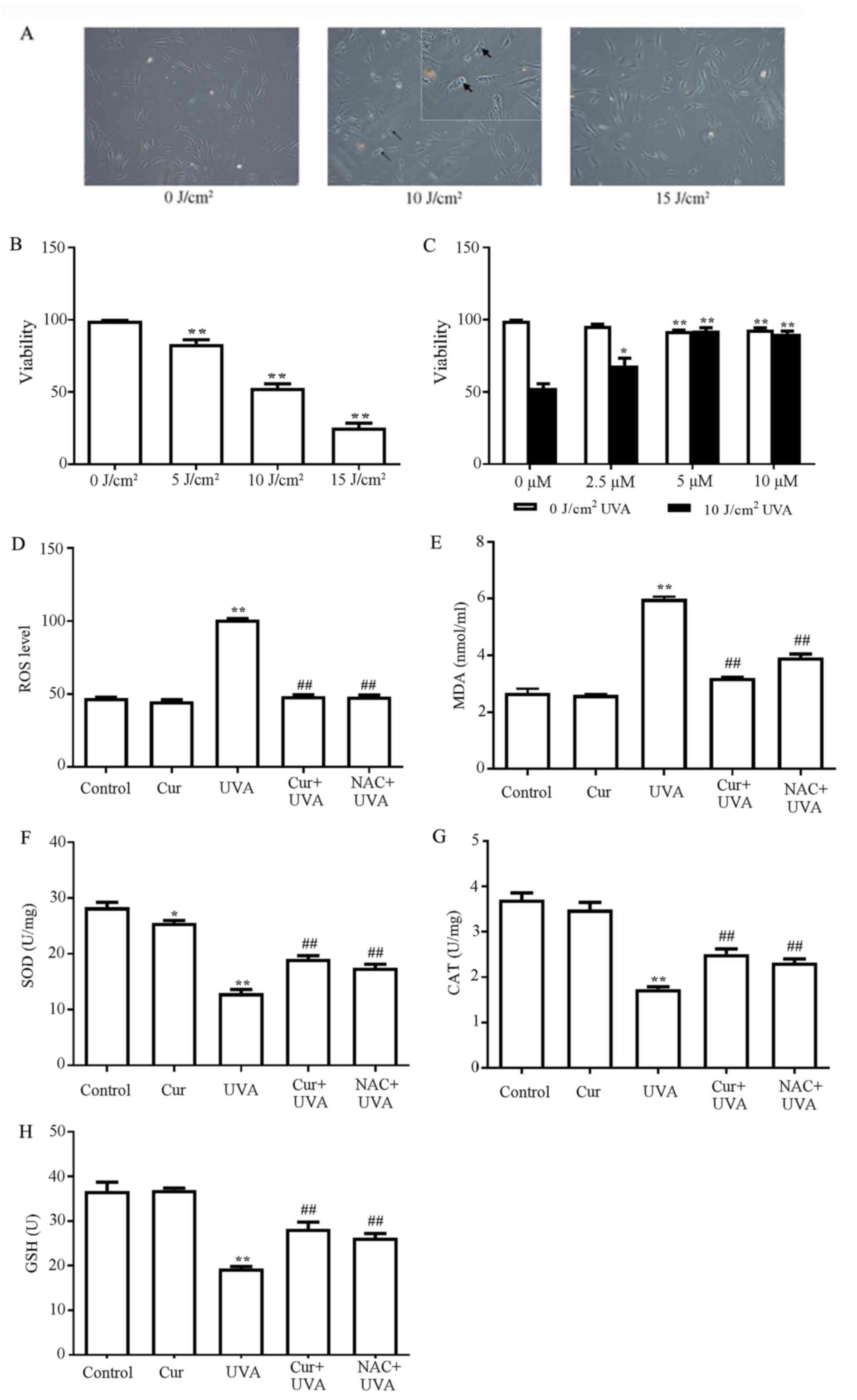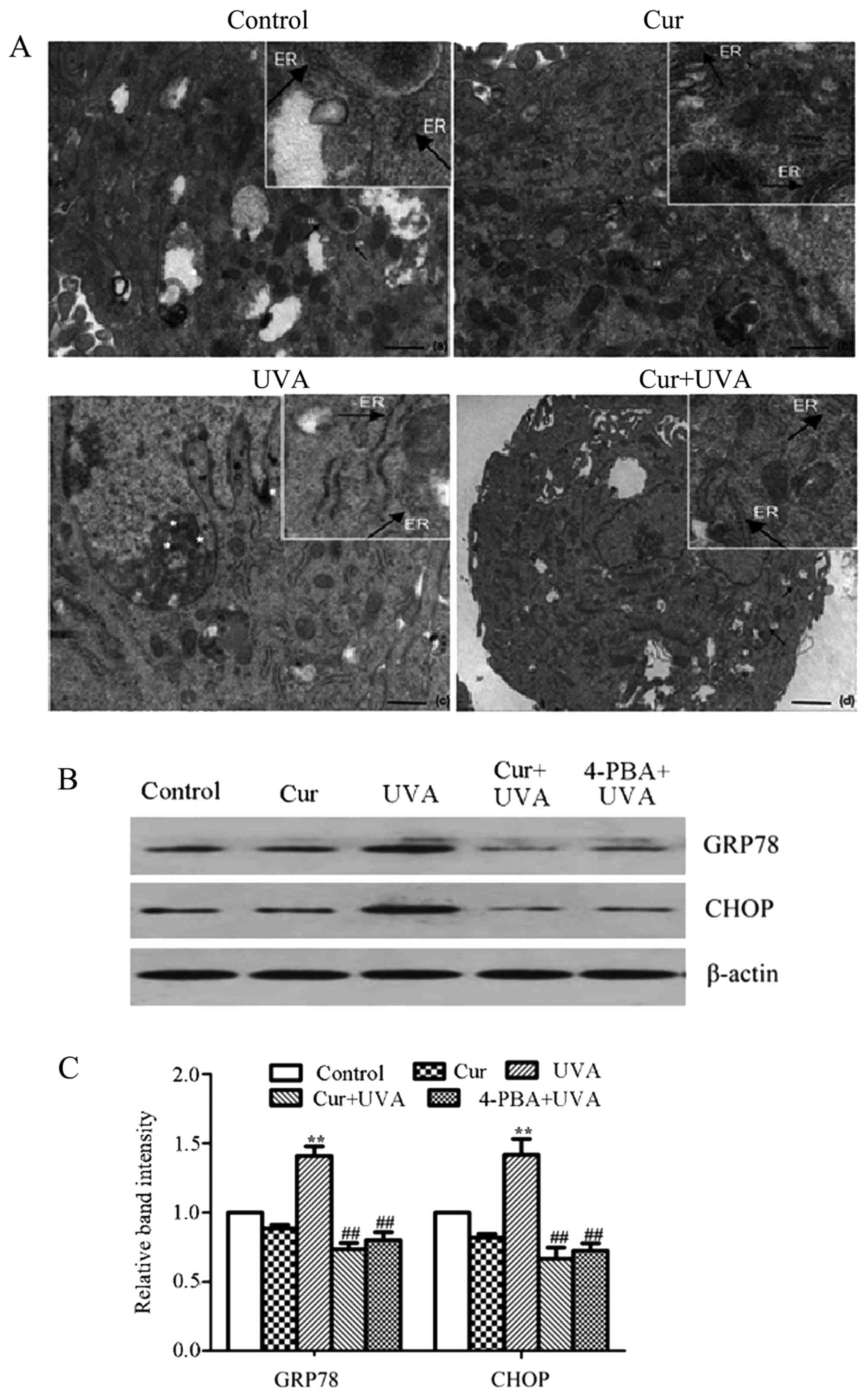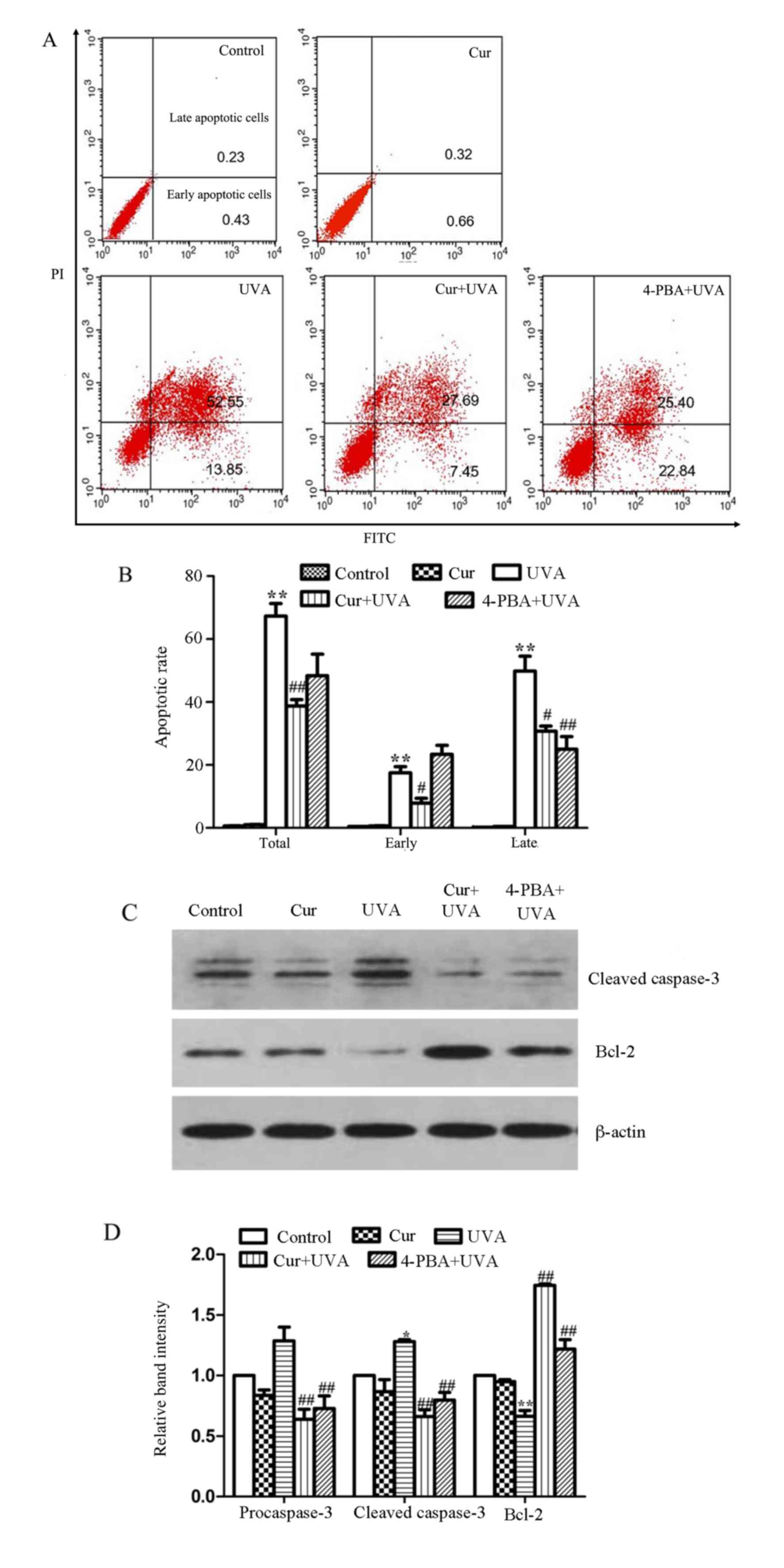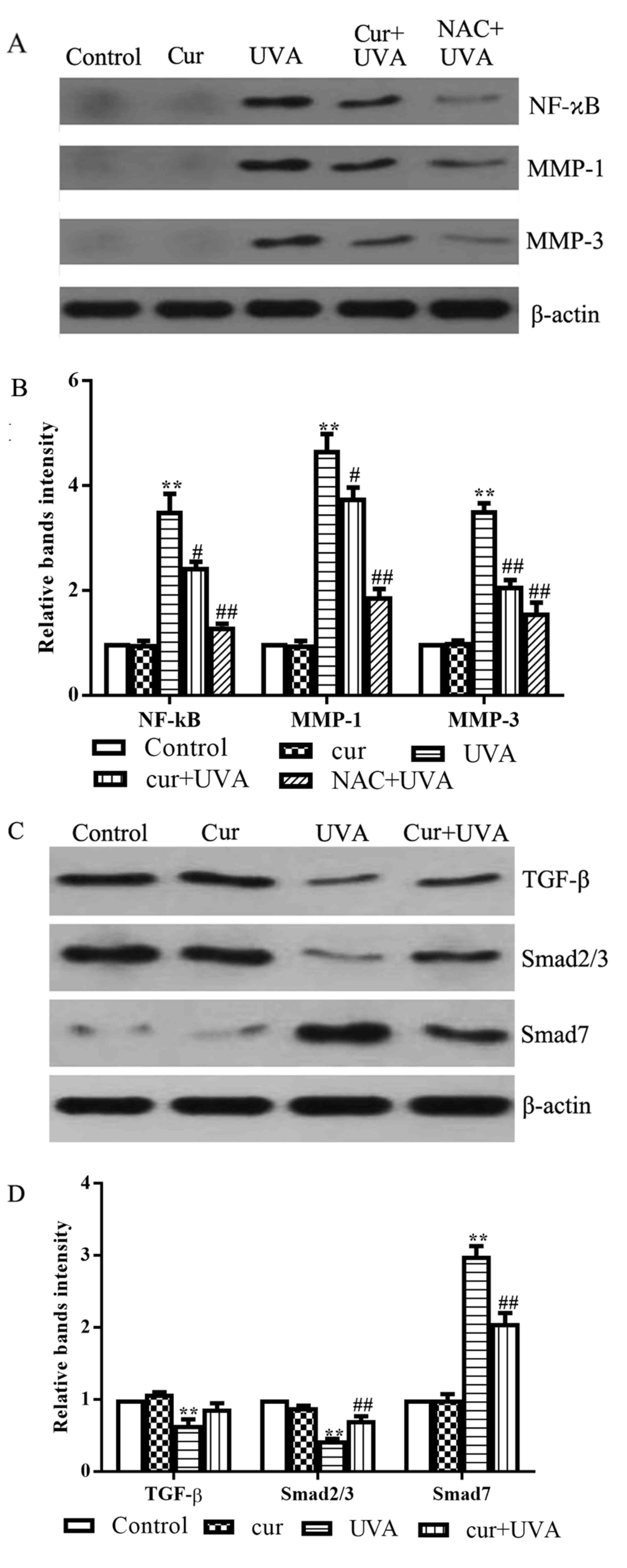|
1
|
Parrish JA, Jaenicke RF and Anderson RR:
Erythema and melanogenesis action spectra of normal human skin.
Photochem Photobiol. 36:187–191. 1982. View Article : Google Scholar : PubMed/NCBI
|
|
2
|
Miller DL and Weinstock MA: Nonmelanoma
skin cancer in the United States: Incidence. J Am Acad Dermatol.
30:774–778. 1994. View Article : Google Scholar : PubMed/NCBI
|
|
3
|
Kochevar IE: Molecular and cellular
effects of UV radiation relevant to chronic photodamageBilchrest
BA: Photodamage. Blackwell, MA: pp. 51–58. 1995
|
|
4
|
Jiang Y, Rabbi M, Kim M, Ke C, Lee W,
Clark RL, Mieczkowski PA and Marszalek PE: UVA generates pyrimidine
dimers in DNA directly. Biophys J. 96:1151–1158. 2009. View Article : Google Scholar : PubMed/NCBI
|
|
5
|
Heng MC: Curcumin targeted signaling
pathways: Basis for anti-photoaging and anti-carcinogenic therapy.
Int J Dermatol. 49:608–622. 2010. View Article : Google Scholar : PubMed/NCBI
|
|
6
|
Brugè F, Damiani E, Puglia C, Offerta A,
Armeni T, Littarru GP and Tiano L: Nanostructured lipid carriers
loaded with CoQ10: Effect on human dermal fibroblasts under normal
and UVA-mediated oxidative conditions. Int J Pharm. 455:348–356.
2013. View Article : Google Scholar : PubMed/NCBI
|
|
7
|
Offord EA, Gautier JC, Avanti O, Scaletta
C, Runge F, Krämer K and Applegate LA: Photoprotective potential of
lycopene, beta-carotene, vitamin E, vitamin C and carnosic acid in
UVA-irradiated human skin fibroblasts. Free Radic Biol Med.
32:1293–1303. 2002. View Article : Google Scholar : PubMed/NCBI
|
|
8
|
Wolosik K, Zareba I, Surazynski A and
Markowska A: The possible pre- and post-UVA radiation protective
effect of amaranth oil on human skin fibroblast cells. Pharmacogn
Mag. 13 Suppl 2:S339–S343. 2017. View Article : Google Scholar : PubMed/NCBI
|
|
9
|
Jagetia GC and Aggarwal BB: ‘Spicing up’
of the immune system by curcumin. J Clin Immunol. 27:19–35. 2007.
View Article : Google Scholar : PubMed/NCBI
|
|
10
|
Ammon H and Wahl MA: Pharmacology of
Curcuma longa. Planta Med. 57:1–7. 1991. View Article : Google Scholar : PubMed/NCBI
|
|
11
|
Tilak J, Banerjee M, Mohan H and
Devasagayam PA: Antioxidant availability of turmeric in relation to
its medicinal and culinary uses. Phytother Res. 18:798–804. 2004.
View Article : Google Scholar : PubMed/NCBI
|
|
12
|
Azuine MA and Bhide SV: Chemopreventive
effect of turmeric against stomach and skin tumors induced by
chemical carcinogens in Swiss mice. Nutr Cancer. 17:77–83. 1992.
View Article : Google Scholar : PubMed/NCBI
|
|
13
|
Huang M, Smart RC, Wong CQ and Conney AH:
Inhibitory effect of curcumin, chlorogenic acid, caffeic acid, and
ferulic acid on tumor promotion in mouse skin by
12-O-tetradecanoylphorbol-13-acetate. Cancer Res. 48:5941–5946.
1988.PubMed/NCBI
|
|
14
|
Inano H, Onoda M, Inafuku N, Kubota M,
Kamada Y, Osawa T, Kobayashi H and Wakabayashi K: Chemoprevention
by curcumin during the promotion stage of tumorigenesis of mammary
gland in rats irradiated with gamma-rays. Carcinogenesis.
20:1011–1018. 1999. View Article : Google Scholar : PubMed/NCBI
|
|
15
|
Inano H, Onoda M, Inafuku N, Kubota M,
Kamada Y, Osawa T, Kobayashi H and Wakabayashi K: Potent preventive
action of curcumin on radiation-induced initiation of mammary
tumorigenesis in rats. Carcinogenesis. 21:1835–1841. 2000.
View Article : Google Scholar : PubMed/NCBI
|
|
16
|
Hwang BM, Noh EM, Kim JS, Kim JM, You YO,
Hwang JK, Kwon KB and Lee YR: Curcumin inhibits UVB-induced matrix
metalloproteinase-1/3 expression by suppressing the MAPK-p38/JNK
pathways in human dermal fibroblasts. Exp Dermatol. 22:358–379.
2013. View Article : Google Scholar : PubMed/NCBI
|
|
17
|
Tsai KD, Lin JC, Yang SM, Tseng MJ, Hsu
JD, Lee YJ and Cherng JM: Curcumin protects against UVB-induced
skin cancers in SKH-1 hairless mouse: Analysis of early molecular
markers in carcinogenesis. Evid Based Complement Alternat Med.
2012:5939522012. View Article : Google Scholar : PubMed/NCBI
|
|
18
|
Li JK and Lin-Shiau SY: Mechanisms of
cancer chemoprevention by curcumin. Proc Natl Sci Counc Repub China
B. 25:pp. 59–66. 2001; PubMed/NCBI
|
|
19
|
Szegezdi E, Logue SE, Gorman AM and Samali
A: Mediators of endoplasmic reticulum stress-induced apoptosis.
EMBO Rep. 7:880–885. 2006. View Article : Google Scholar : PubMed/NCBI
|
|
20
|
Fisher GJ, Wang Z, Datta SC, Varani J,
Kang S and Voorhees JJ: Pathophysiology of premature skin aging
induced by ultraviolet light. N Engl J Med. 337:1419–1428. 1997.
View Article : Google Scholar : PubMed/NCBI
|
|
21
|
Polte T and Tyrrell RM: Involvement of
lipid peroxidation and organic peroxides in UVA-induced matrix
metalloproteinase-1 expression. Free Radic Biol Med. 36:1566–1574.
2004. View Article : Google Scholar : PubMed/NCBI
|
|
22
|
Brennan M, Bhatti H, Nerusu KC,
Bhagavathula N, Kang S, Fisher GJ, Varani J and Voorhees JJ: Matrix
metalloproteinase-1 is the major collagenolytic enzyme responsible
for collagen damage in UV-irradiated human skin. Photochem
Photobiol. 78:43–48. 2003. View Article : Google Scholar : PubMed/NCBI
|
|
23
|
Liu W, Wang DR and Cao YL: TGF-beta: A
fibrotic factor in wound scarring and a potential target for
anti-scarring gene therapy. Curr Gene Ther. 4:123–136. 2004.
View Article : Google Scholar : PubMed/NCBI
|
|
24
|
Kopp J, Preis E, Said H, Hafemann B,
Wickert L, Gressner AM, Pallua N and Dooley S: Abrogation of
transforming growth factor-beta signaling by SMAD7 inhibits
collagen gel contraction of human dermal fibroblasts. J Biol Chem.
280:21570–21576. 2005. View Article : Google Scholar : PubMed/NCBI
|
|
25
|
Lan HY: Diverse roles of TGF-β/Smads in
renal fibrosis and inflammation. Int J Biol Sci. 7:1056–1067. 2011.
View Article : Google Scholar : PubMed/NCBI
|
|
26
|
Li JH, Huang XR, Zhu HJ, Oldfield M,
Cooper M, Truong LD, Johnson RJ and Lan HY: Advanced glycation end
products activate Smad signaling via TGF-beta-dependent and
independent mechanisms: Implications for diabetic renal and
vascular disease. Faseb J. 18:176–178. 2004. View Article : Google Scholar : PubMed/NCBI
|
|
27
|
Chung AC, Zhang H, Kong YZ, Tan JJ, Huang
XR, Kopp JB and Lan HY: Advanced glycation end-products induce
tubular CTGF via TGF-beta-independent Smad3 signaling. J Am Soc
Nephrol. 21:249–260. 2010. View Article : Google Scholar : PubMed/NCBI
|
|
28
|
Douglas RH, Moan J and Rontb G: Light in
Biology and Medicine. Plenum; New York 2: 1991, View Article : Google Scholar
|
|
29
|
Cadet J, Berger M, Douki T, Morin B, Raoul
S, Ravanat JL and Spinelli S: Effects of UV and visible radiation
on DNA-final base damage. Biol. Chem. 378:1275–1286. 1997.
|
|
30
|
Cadet J, Berger M, Decarroz C, Wagner JR,
van Lier JE, Ginot YM and Vigny P: Photosensitized reactions of
nucleic acids. Biochimie. 68:813–834. 1986. View Article : Google Scholar : PubMed/NCBI
|
|
31
|
Fisher GJ, Kang S, Varani J, Bata-Csorgo
Z, Wan Y, Datta S and Voorhees JJ: Mechanisms of photoaging and
chronological skin aging. Arch Dermatol. 138:1462–1770. 2002.
View Article : Google Scholar : PubMed/NCBI
|
|
32
|
Afaq F and Mukhtar H: Effects of solar
radiation on cutaneous detoxification pathways. J Photochem
Photobiol B. 63:61–69. 2001. View Article : Google Scholar : PubMed/NCBI
|
|
33
|
Shindo Y, Witt E and Packer L: Antioxidant
defense mechanisms in murine epidermis and dermis and their
responses to ultraviolet light. J Invest Dermatol. 100:260–265.
1993. View Article : Google Scholar : PubMed/NCBI
|
|
34
|
Sharma RA, Ireson CR, Verschoyle RD, Hill
KA, Williams ML, Leuratti C, Manson MM, Marnett LJ, Steward WP and
Gescher A: Effects of dietary curcumin on glutathione S-transferase
and malonaldehyde-DNA adducts in rat liver and colon mucosa:
Relationship with drug levels. Clin Cancer Res. 7:1452–1458.
2001.PubMed/NCBI
|
|
35
|
Zhang KZ and Kaufman RJ: From
endoplasmic-reticulum stress to the inflammatory response. Nature.
454:455–462. 2008. View Article : Google Scholar : PubMed/NCBI
|
|
36
|
Ron D and Walter P: Signal integration in
the endoplasmic reticulum unfolded protein response. Nat Rev Mol
Cell Biol. 8:519–529. 2007. View Article : Google Scholar : PubMed/NCBI
|
|
37
|
Schröder M and Kaufman RJ: The mammalian
unfolded protein response. Annu Rev Biochem. 74:739–789. 2005.
View Article : Google Scholar : PubMed/NCBI
|
|
38
|
Lu PD, Harding HP and Ron D: Translation
reinitiation at alternative open reading frames regulates gene
expression in an integrated stress response. J Cell Biol.
167:27–33. 2004. View Article : Google Scholar : PubMed/NCBI
|
|
39
|
Harding HP, Novoa I, Zhang Y, Zeng H, Wek
R, Schapira M and Ron D: Regulated translation initiation controls
stress-induced gene expression in mammalian cells. Mol Cell.
6:1099–1108. 2000. View Article : Google Scholar : PubMed/NCBI
|
|
40
|
Soter NA: Sunburn and suntan: Immediate
manifestations of photodamageGilchrest BA: Photodamage. Cambridge
(MA): Blackwell Science; pp. 12–25. 1995
|
|
41
|
Herrmann G, Wlaschek M, Bolsen K, Prenzel
K, Goerz G and Scharffetter-Kochanek K: Pathogenic implication of
matrix-metalloproteinases (MMPs) and their counteracting inhibitor
TIMP-1 in the cutaneous photodamage of human porphyria cutanea
tarda (PCT). J Invest Dermatol. 107:398–403. 1996. View Article : Google Scholar : PubMed/NCBI
|
|
42
|
Wlaschek M, Briviba K, Stricklin GP, Sies
H and Scharffetter-Kochanek K: Singlet oxygen may mediate the
ultraviolet A-induced synthesis of interstitial collagenase. J
Invest Dermatol. 104:194–198. 1995. View Article : Google Scholar : PubMed/NCBI
|
|
43
|
Scharffetter-Kochanek K, Wlaschek M,
Briviba K and Sies H: Singlet oxygen induces collagenase expression
in human skin fibroblasts. FEBS Lett. 331:304–306. 1993. View Article : Google Scholar : PubMed/NCBI
|
|
44
|
Wenk J, Brenneisen P, Wlaschek M, Poswig
A, Briviba K, Oberley TD and Scharffetter-Kochanek K: Stable
overexpression of manganese superoxide dismutase in mitochondria
identifies hydrogen peroxide as a major oxidant in the
AP-1-mediated induction of matrix-degrading metalloproteinase-1. J
Biol Chem. 274:25869–25876. 1999. View Article : Google Scholar : PubMed/NCBI
|
|
45
|
Pandel R, Poljšak B, Godic A and Dahmane
R: Skin photoaging and the role of antioxidants in its prevention.
ISRN Dermatol. 2013:9301642013. View Article : Google Scholar : PubMed/NCBI
|
|
46
|
Erman H, Gelisgen R, Cengiz M, Tabak O,
Erdenen F and Uzun H: The association of vascular endothelial
growth factor, metalloproteinases and their tissue inhibitors with
cardiovascular risk factors in the metabolic syndrome. Eur Rev Med
Pharmacol Sci. 20:1015–1022. 2016.PubMed/NCBI
|
|
47
|
Kryger ZB, Sisco M, Roy NK, Lu L,
Rosenberg D and Mustoe TA: Temporal expression of the transforming
growth factor-Beta pathway in the rabbit ear model of wound healing
and scarring. J Am Coll Surg. 205:78–88. 2007. View Article : Google Scholar : PubMed/NCBI
|
|
48
|
Leask A and Abraham DJ: TGF-beta signaling
and the fibrotic response. FASEB J. 18:816–827. 2004. View Article : Google Scholar : PubMed/NCBI
|
|
49
|
Massagué J: TGF-beta signal transduction.
Annu Rev Biochem. 67:753–791. 1998. View Article : Google Scholar : PubMed/NCBI
|
|
50
|
Massagué J and Chen YG: Controlling
TGF-beta signaling. Genes Dev. 14:627–644. 2000.PubMed/NCBI
|
|
51
|
Massagué J and Wotton D: Transcriptional
control by the TGF-beta/Smad signaling system. EMBO J.
19:1745–1754. 2000. View Article : Google Scholar : PubMed/NCBI
|
|
52
|
Piek E, Heldin CH and Ten Dijke P:
Specificity, diversity, and regulation in TGF-beta superfamily
signaling. FASEB J. 13:2105–2124. 1999. View Article : Google Scholar : PubMed/NCBI
|














